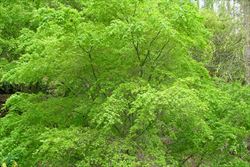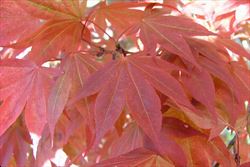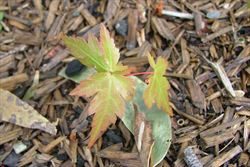Click on images to enlarge

habit in spring (Photo: Sheldon Navie)

palmately-lobed leaves (Photo: Sheldon Navie)

younger stems and leaf undersides (Photo: Sheldon Navie)

autumn leaves (Photo: Sheldon Navie)

flowers, some of which are male and some of which are bisexual (Photo: Sheldon Navie)

close-up of seeds (Photo: Tracey Slotta at USDA PLANTS Database)

seedling (Photo: Sheldon Navie)
Scientific Name
Acer palmatum Thunb.
Family
Aceraceae
Common Names
Japanese maple
Origin
Native to eastern Asia (i.e. Korea and Japan, and possibly also China and Taiwan).
Naturalised Distribution
This species is only recorded as being sparingly naturalised near Melbourne in southern Victoria. Herbarium records may underestimate its actual distribution, because there are unconfirmed reports that it is naturalised in the Central Tablelands region in New South Wales.
Notes
Japanese maple (Acer palmatum) is one of the most commonly cultivated ornamental deciduous trees in the temperate regions of Australia. There are numerous cultivars available, which often vary in leaf shape and in the colour of their autumn foliage. This species has begun to escape cultivation in the cooler and wetter parts of south-eastern Australia in recent years and should be regarded as an emerging environmental weed.
It was first recorded as naturalised in Victoria in 1985, and small populations are known to be present in the Dandenong Ranges north of Melbourne. Even though it is not yet listed as being naturalised in New South Wales, it has also been reported to be weedy throughout the Blue Mountains City Council area. It is not yet a serious pest in this region, but occurs regularly enough to be recognised as being weedy by the local authority. It is also on the Australia Association of Bush Regenerators (AABR) environmental weed list for the wider Sydney and Blue Mountains region.

